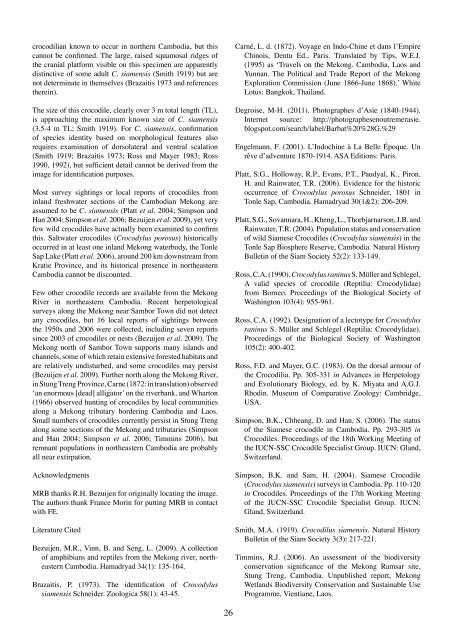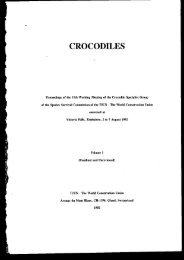size: 992KB - Crocodile Specialist Group
size: 992KB - Crocodile Specialist Group
size: 992KB - Crocodile Specialist Group
Create successful ePaper yourself
Turn your PDF publications into a flip-book with our unique Google optimized e-Paper software.
crocodilian known to occur in northern Cambodia, but this<br />
cannot be confirmed. The large, raised squamosal ridges of<br />
the cranial platform visible on this specimen are apparently<br />
distinctive of some adult C. siamensis (Smith 1919) but are<br />
not determinate in themselves (Brazaitis 1973 and references<br />
therein).<br />
The <strong>size</strong> of this crocodile, clearly over 3 m total length (TL),<br />
is approaching the maximum known <strong>size</strong> of C. siamensis<br />
(3.5-4 m TL; Smith 1919). For C. siamensis, confirmation<br />
of species identity based on morphological features also<br />
requires examination of dorsolateral and ventral scalation<br />
(Smith 1919; Brazaitis 1973; Ross and Mayer 1983; Ross<br />
1990, 1992), but sufficient detail cannot be derived from the<br />
image for identification purposes.<br />
Most survey sightings or local reports of crocodiles from<br />
inland freshwater sections of the Cambodian Mekong are<br />
assumed to be C. siamensis (Platt et al. 2004; Simpson and<br />
Han 2004; Simpson et al. 2006; Bezuijen et al. 2009), yet very<br />
few wild crocodiles have actually been examined to confirm<br />
this. Saltwater crocodiles (Crocodylus porosus) historically<br />
occurred in at least one inland Mekong waterbody, the Tonle<br />
Sap Lake (Platt et al. 2006), around 200 km downstream from<br />
Kratie Province, and its historical presence in northeastern<br />
Cambodia cannot be discounted.<br />
Few other crocodile records are available from the Mekong<br />
River in northeastern Cambodia. Recent herpetological<br />
surveys along the Mekong near Sambor Town did not detect<br />
any crocodiles, but 16 local reports of sightings between<br />
the 1950s and 2006 were collected, including seven reports<br />
since 2003 of crocodiles or nests (Bezuijen et al. 2009). The<br />
Mekong north of Sambor Town supports many islands and<br />
channels, some of which retain extensive forested habitats and<br />
are relatively undisturbed, and some crocodiles may persist<br />
(Bezuijen et al. 2009). Further north along the Mekong River,<br />
in Stung Treng Province, Carne (1872: in translation) observed<br />
‘an enormous [dead] alligator’ on the riverbank, and Wharton<br />
(1966) observed hunting of crocodiles by local communities<br />
along a Mekong tributary bordering Cambodia and Laos.<br />
Small numbers of crocodiles currently persist in Stung Treng<br />
along some sections of the Mekong and tributaries (Simpson<br />
and Han 2004; Simpson et al. 2006; Timmins 2006), but<br />
remnant populations in northeastern Cambodia are probably<br />
all near extirpation.<br />
Acknowledgments<br />
MRB thanks R.H. Bezuijen for originally locating the image.<br />
The authors thank France Morin for putting MRB in contact<br />
with FE.<br />
Literature Cited<br />
Bezuijen, M.R., Vinn, B. and Seng, L. (2009). A collection<br />
of amphibians and reptiles from the Mekong river, northeastern<br />
Cambodia. Hamadryad 34(1): 135-164.<br />
Brazaitis, P. (1973). The identification of Crocodylus<br />
siamensis Schneider. Zoologica 58(1): 43-45.<br />
Carné, L. d. (1872). Voyage en Indo-Chine et dans l’Empire<br />
Chinois, Dentu Ed., Paris. Translated by Tips, W.E.J.<br />
(1995) as ‘Travels on the Mekong. Cambodia, Laos and<br />
Yunnan. The Political and Trade Report of the Mekong<br />
Exploration Commission (June 1866-June 1868).’ White<br />
Lotus: Bangkok, Thailand.<br />
Degroise, M-H. (2011). Photographes d’Asie (1840-1944).<br />
Internet source: http://photographesenoutremerasie.<br />
blogspot.com/search/label/Barbat%20%28G.%29<br />
Engelmann, F. (2001). L’Indochine à La Belle Époque. Un<br />
rêve d’adventure 1870-1914. ASA Editions: Paris.<br />
Platt, S.G., Holloway, R.P., Evans, P.T., Paudyal, K., Piron,<br />
H. and Rainwater, T.R. (2006). Evidence for the historic<br />
occurrence of Crocodylus porosus Schneider, 1801 in<br />
Tonle Sap, Cambodia. Hamadryad 30(1&2): 206-209.<br />
Platt, S.G., Sovannara, H., Kheng, L., Thorbjarnarson, J.B. and<br />
Rainwater, T.R. (2004). Population status and conservation<br />
of wild Siamese <strong>Crocodile</strong>s (Crocodylus siamensis) in the<br />
Tonle Sap Biosphere Reserve, Cambodia. Natural History<br />
Bulletin of the Siam Society 52(2): 133-149.<br />
Ross, C.A. (1990). Crocodylus raninus S. Müller and Schlegel,<br />
A valid species of crocodile (Reptilia: Crocodylidae)<br />
from Borneo. Proceedings of the Biological Society of<br />
Washington 103(4): 955-961.<br />
Ross, C.A. (1992). Designation of a lectotype for Crocodylus<br />
raninus S. Müller and Schlegel (Reptilia: Crocodylidae).<br />
Proceedings of the Biological Society of Washington<br />
105(2): 400-402.<br />
Ross, F.D. and Mayer, G.C. (1983). On the dorsal armour of<br />
the Crocodilia. Pp. 305-331 in Advances in Herpetology<br />
and Evolutionary Biology, ed. by K. Miyata and A.G.J.<br />
Rhodin. Museum of Comparative Zoology: Cambridge,<br />
USA.<br />
Simpson, B.K., Chheang, D. and Han, S. (2006). The status<br />
of the Siamese crocodile in Cambodia. Pp. 293-305 in<br />
<strong>Crocodile</strong>s. Proceedings of the 18th Working Meeting of<br />
the IUCN-SSC <strong>Crocodile</strong> <strong>Specialist</strong> <strong>Group</strong>. IUCN: Gland,<br />
Switzerland.<br />
Simpson, B.K. and Sam, H. (2004). Siamese <strong>Crocodile</strong><br />
(Crocodylus siamensis) surveys in Cambodia. Pp. 110-120<br />
in <strong>Crocodile</strong>s. Proceedings of the 17th Working Meeting<br />
of the IUCN-SSC <strong>Crocodile</strong> <strong>Specialist</strong> <strong>Group</strong>. IUCN:<br />
Gland, Switzerland.<br />
Smith, M.A. (1919). Crocodilus siamensis. Natural History<br />
Bulletin of the Siam Society 3(3): 217-221.<br />
Timmins, R.J. (2006). An assessment of the biodiversity<br />
conservation significance of the Mekong Ramsar site,<br />
Stung Treng, Cambodia. Unpublished report, Mekong<br />
Wetlands Biodiversity Conservation and Sustainable Use<br />
Programme, Vientiane, Laos.<br />
26

















